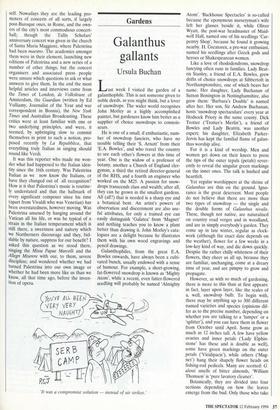Gardens
Galanthus gallants
Ursula Buchan
Last week I visited the garden of a galanthophile. This is not someone given to noble deeds, as you might think, but a lover of snowdrops. The wider world recognises John Morley as a highly accomplished painter, but gardeners know him better as a supplier of choice snowdrops to connois- seurs.
He is one of a small, if enthusiastic, num- ber of snowdrop fanciers, who have no trouble telling their 'S. Arnott' from their `E.A. Bowles', and who travel the country to see each other's flowers at this time of year. One is the widow of a professor of botany, another a Church of England cler- gyman, a third the retired director-general of the RHS, and a fourth an engineer who worked on the M25. A passion for snow- drops transcends class and wealth; after all, they can be grown in the smallest gardens. All (all?) that is needed is a sharp eye and a botanical bent. An artist's powers of observation and discernment are also use- ful attributes, for only a trained eye can easily distinguish 'Galatea' from 'Magnet' and nothing teaches you to know a plant better than drawing it. John Morley's cata- logues are a delight because he illustrates them with his own wood engravings and pencil drawings.
Galanthophiles, from the great E.A. Bowles onwards, have always been a culti- vated bunch, usually endowed with a sense of humour. For example, a short-growing, fat-flowered snowdrop is known as 'Mighty Atom', while a recent, even fatter-flowered seedling will probably be named 'Almighty It was a compromise solution — instead of air strikes.' Atom'. `Backhouse Spectacles' is so-called because the eponymous nurseryman's wife left her glasses beside it, while Oliver Wyatt, the post-war headmaster of Maid- well Hall, named one of his seedlings 'Car- pentry Shop', because he found it growing nearby. H. Greatorex, a pre-war enthusiast, named his seedlings after Greek gods and heroes or Shakespearean women.
Like a love of rhododendrons, snowdrop fancying often runs in families. Lady Beat- rix Stanley, a friend of E.A. Bowles, grew drifts of choice snowdrops at Sibbertoft in Northamptonshire, one of which bears her name. Her daughter, Lady Buchanan of Sutton Bonington in Nottinghamshire, also grew them: 'Barbara's Double' is named after her. Her son, Sir Andrew Buchanan, hosts 'snowdrop spectaculars' every year at Hodsock Priory in the same county. Dick Trotter (`Trotter's Merlin'), a friend of Bowles and Lady Beatrix, was another expert; his daughter, Elizabeth Parker- Jervis has kept the familial flame of galan- thus worship alive.
For it is a kind of worship. Men and women get down on their knees to press the tips of the outer tepals (petals) rever- ently to reveal the singular green markings on the inner ones. The talk is hushed and heartfelt.
Yet regular worshippers at the shrine of Galanthus are thin on the ground. Igno- rance is the great deterrent. Most people do not believe that there are more than two types of snowdrop — the single and the double forms of Galanthus nivalis. These, though not native, are naturalised on country road verges and in woodland, and are in simply everybody's garden. They come up in late winter, regular as clock- work (although the exact date depends on the weather), flower for a few weeks in a low-key kind of way, and die down quickly. Despite the rather chilly whiteness of their flowers, they cheer us all up, because they are familiar, unchanging, come at a dreary time of year, and are pimpsy to grow and propagate.
However, as with so much of gardening, there is more to this than at first appears: in fact, layer upon layer, like the scales of a, well, snowdrop bulb. To begin with, there may be anything up to 300 different named varieties and species (opinions dif- fer as to the precise number, depending on whether you are talking to a lumper' or a 'splitter'), and you can have them in flower from October until April. Some grow as much as 12 inches tall. A few have yellow ovaries and inner petals (`Lady Elphin- stone' has these and is double as well), some have green markings on the outer petals (`Viridipacis'), while others (Mag- net') hang their shapely flower heads on fishing-rod pedicels. Many are scented: G. alenii smells of bitter almonds, 'William Thomson' is 'pure lavatory cleaner'.
Botanically, they are divided into four sections depending on how the leaves emerge from the bud. Only those who take the trouble to learn the difference between explicate and applanate, revolute and supervolute (easier done than spelled) ever truly get the hang of them.
Concentrating on a particular plant genus has an addictive fascination. You hold yourself in readiness all year, pre- pared to revel for a few short weeks which, in this case, are often spoiled by the weath- er. When things work out the satisfaction is, therefore, intense. John Morley says that an interest in all the snowdrops reconciles him to the winter, which he used to dislike. You can see his point.
John Morley's catalogue may be obtained, for .fl plus a first-class stamp, from North Green Only, Stoven, Beccles, Suffolk, NR34 8DG. The bulbs are sent out in March and April.



















































 Previous page
Previous page